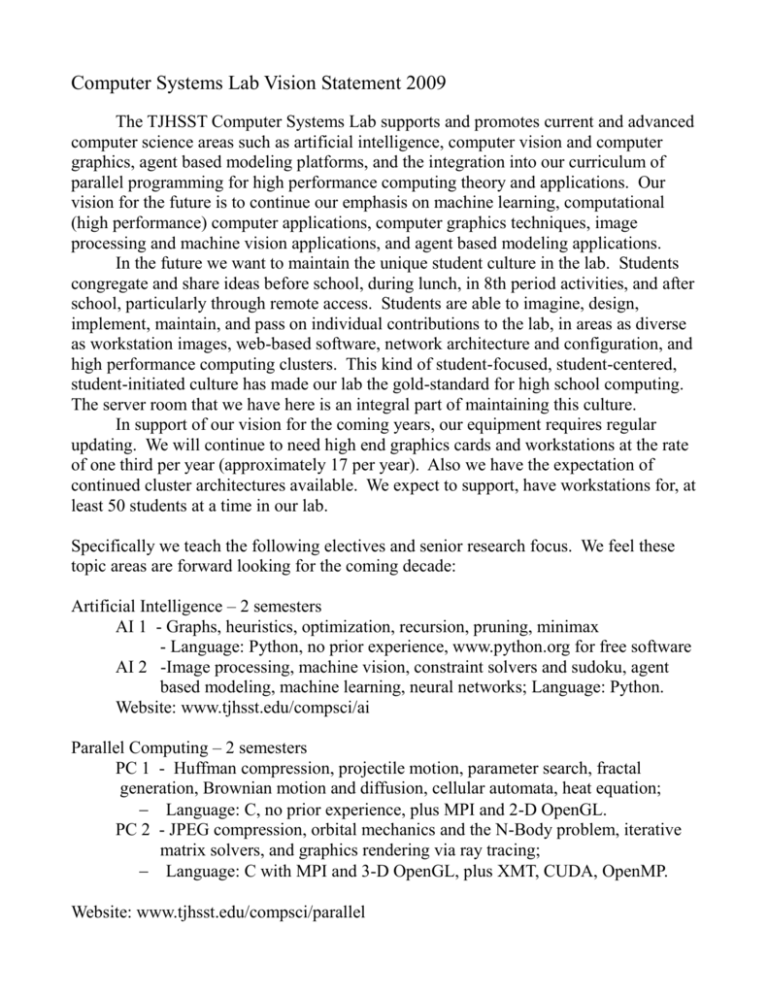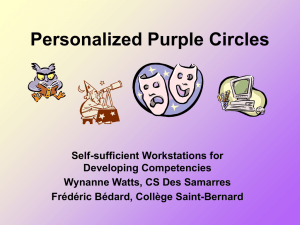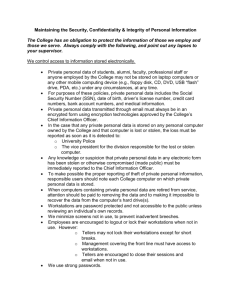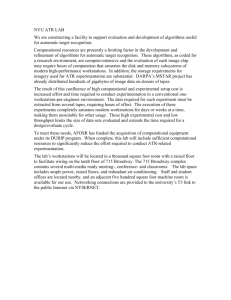CompSysLabVisionStat..
advertisement

Computer Systems Lab Vision Statement 2009 The TJHSST Computer Systems Lab supports and promotes current and advanced computer science areas such as artificial intelligence, computer vision and computer graphics, agent based modeling platforms, and the integration into our curriculum of parallel programming for high performance computing theory and applications. Our vision for the future is to continue our emphasis on machine learning, computational (high performance) computer applications, computer graphics techniques, image processing and machine vision applications, and agent based modeling applications. In the future we want to maintain the unique student culture in the lab. Students congregate and share ideas before school, during lunch, in 8th period activities, and after school, particularly through remote access. Students are able to imagine, design, implement, maintain, and pass on individual contributions to the lab, in areas as diverse as workstation images, web-based software, network architecture and configuration, and high performance computing clusters. This kind of student-focused, student-centered, student-initiated culture has made our lab the gold-standard for high school computing. The server room that we have here is an integral part of maintaining this culture. In support of our vision for the coming years, our equipment requires regular updating. We will continue to need high end graphics cards and workstations at the rate of one third per year (approximately 17 per year). Also we have the expectation of continued cluster architectures available. We expect to support, have workstations for, at least 50 students at a time in our lab. Specifically we teach the following electives and senior research focus. We feel these topic areas are forward looking for the coming decade: Artificial Intelligence – 2 semesters AI 1 - Graphs, heuristics, optimization, recursion, pruning, minimax - Language: Python, no prior experience, www.python.org for free software AI 2 -Image processing, machine vision, constraint solvers and sudoku, agent based modeling, machine learning, neural networks; Language: Python. Website: www.tjhsst.edu/compsci/ai Parallel Computing – 2 semesters PC 1 - Huffman compression, projectile motion, parameter search, fractal generation, Brownian motion and diffusion, cellular automata, heat equation; Language: C, no prior experience, plus MPI and 2-D OpenGL. PC 2 - JPEG compression, orbital mechanics and the N-Body problem, iterative matrix solvers, and graphics rendering via ray tracing; Language: C with MPI and 3-D OpenGL, plus XMT, CUDA, OpenMP. Website: www.tjhsst.edu/compsci/parallel Computer Systems Research The Computer Systems Laboratory supports studies in theoretical and applied computational science, computer architecture, artificial intelligence, and supercomputing. Working in a UNIX environment, students are able to investigate a wide range of pure and applied research topics utilizing a variety of computer languages and styles. Projects fall within a broad spectrum of computer science areas spanning computer graphics, artificial intelligence, computer vision, high performance computing, grid/distributed computing, computational science applications such as computational linguistics, agent based modeling of complex systems including social complexity, software design, and theoretical algorithmic development of ideas as varied as tree data structures to ant colony search optimization. The Computer Systems Laboratory emphasizes a multilingual computer language community, featuring C/C++, Java, Python, Ruby, XML, PHP, Perl, MySQL, JavaScript, Tk, OpenGL, Fortran, Lisp, and MASON (Multi-Agent Simulator of Neighborhoods) and NetLogo for agents based environments. Mentorship opportunities are available in computer science and computational science applications through a variety of businesses and organizations such as the Naval Research Laboratory, Northrop Grumman, George Mason University, and the TurnerFairbank Highway Research Center. Research areas include from AI 1: Graphs amd search techniques; heuristics; games and learning; genetic algorithms and learning, minimax trees. from AI 2: Image processing, machine vision, agent based modeling, machine learning, neural networks. from Parallel Computing 1: Compression techniques, numerical simulation, parallization methods, gridding strategies from Parallel Computing 2: Cellular Automata and parallization, threads and sockets, 3D graphics, parallel platforms other areas include: agent based modeling, computer graphics, computer vision, computational science, computers in education, other applications such as computer music Mentorship with research labs, universities, companies; Competitions -TJ Science fair, Intel, Siemen's; Publication - Teknos Eighth Period Computer Team, www.tjhsst.edu/sct Science Fair Interest 9-11 SEE THE BLUEPRINT BELOW Projection Screen ROOM 115 COMP SYS LAB 10-12 computer workstations White board DOOR Window Projector 10-12 computer Teacher desk workstations and work area Teacher desk and work area SERVER ROOM 10-12 workstations MULTI – NODE COMPUTER CLUSTER (100 nodes) Wall 10-12 workstations White board AIR CONDITIONER MULTIPLE SERVERS (10-12) 10-12 workstations Wall white board Projection screen Projector Classroom area Door Sys Admin workstations and work area 5-8 workstations 30-35 student desks DOOR Piano Door Window Office DOOR Door Door Office/library Office The Computer Systems Lab would like to maintain it's current layout and structural plan in Room 115. See the attached rough sketch of our room and allocations for: approximately 50 student workstations, 5-8 system administrator workstations, 3 offices + 2 additional teacher work areas and desks, classroom area for approximately 30 students, plentiful white board space, 2 projection areas with projectors and screens quality laser printers, at least 2 – one for backup, our printers support printjobs for many students from other classes throughout the day server area with space for large air conditioner, 32+ node cluster, multiple servers We continue to support and promote advanced and current computer science areas such as artificial intelligence, computer vision and computer graphics, agent based modeling platforms, and the integration into our curriculum of parallel programming for high performance computing theory and applications. Vendors used by our lab: HP (workstations, printers) Intel (clusters) ViewSonic (monitors) NVidia (graphics cards) Cisco (networking) Sun (Academic Excellence Grant, 2008)







